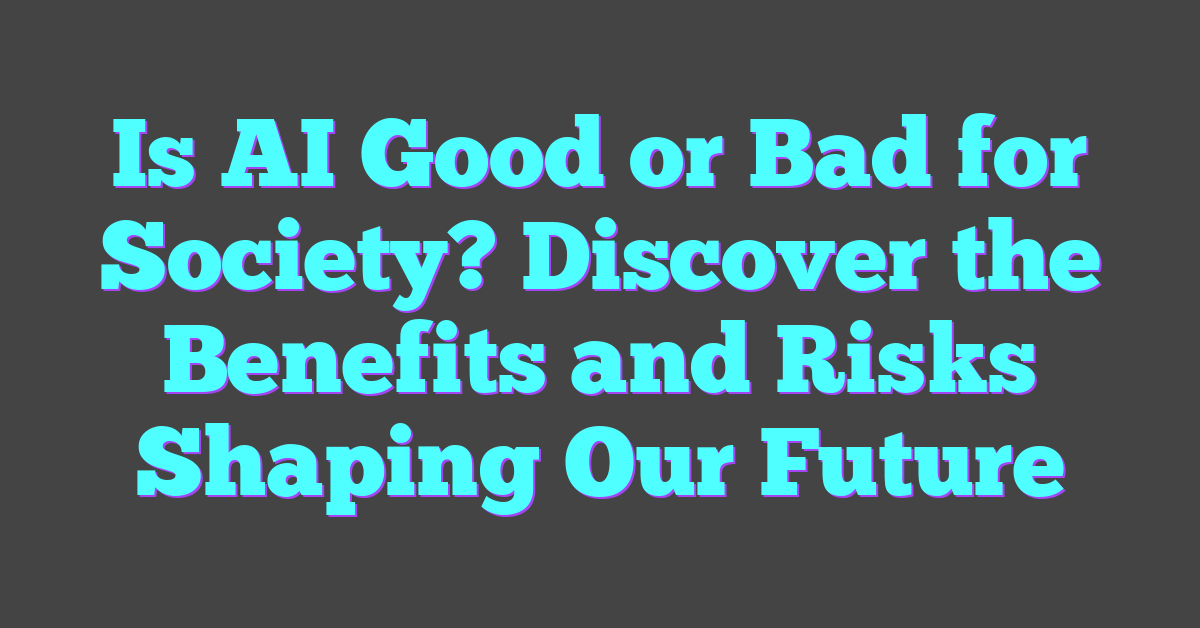Artificial intelligence (AI) is no longer a concept confined to science fiction. It’s woven into the fabric of daily life, from virtual assistants like Siri and Alexa to sophisticated algorithms driving healthcare and finance. As AI continues to evolve, it raises a pressing question: is AI good or bad for society?
On one hand, AI offers remarkable benefits. It can streamline operations, enhance decision-making, and even predict potential crises before they happen. However, there are concerns about job displacement, privacy invasion, and ethical dilemmas. This article delves into both sides of the debate, exploring the potential and pitfalls of AI in shaping our future.
Evaluating the Impact of AI on Society
AI influences many aspects of society, presenting both significant benefits and notable challenges. By delving into these facets, one can gain a clearer understanding of AI’s role in shaping our future.

Benefits of AI in Various Sectors
AI offers remarkable benefits across multiple sectors:
- Healthcare: Enhances diagnostic accuracy and personalizes patient care. For instance, AI algorithms identify diseases in medical imaging with high precision.
- Education: Tailors learning experiences to individual students. Adaptive learning platforms adjust content based on student performance.
- Finance: Strengthens fraud detection and improves risk management. Machine learning models analyze large datasets to detect suspicious activities.
- Transportation: Optimizes traffic management and enhances safety. Autonomous vehicles use AI to reduce accidents caused by human error.
- Manufacturing: Streamlines operations and predicts maintenance needs. Predictive analytics prevent equipment failures, ensuring smooth production processes.
Challenges and Concerns Associated With AI
Despite its benefits, AI raises several concerns:
- Job Displacement: Automation may lead to job losses in certain industries. For example, AI-driven machines can replace repetitive manual labor roles.
- Privacy Issues: Data collection and analysis pose privacy risks. Personal data used in AI algorithms may be misused or exposed.
- Bias and Discrimination: Algorithms can perpetuate existing biases. If trained on biased data, AI systems may produce unfair outcomes.
- Ethical Dilemmas: Decision-making by AI can lead to ethical conflicts. Autonomous systems must navigate complex moral scenarios without human guidance.
- Security Threats: AI enhances cyberattack capabilities. Malicious actors can exploit AI to create more sophisticated and targeted attacks.
By understanding the dual nature of AI’s impact, society can better navigate its integration into daily life, maximizing benefits while mitigating risks.
AI in Healthcare: Revolutionizing Medical Treatment
AI is transforming healthcare by enhancing diagnostic accuracy and creating new treatment possibilities.
Improved Diagnostic Accuracy
AI has bolstered diagnostic accuracy significantly in healthcare. Algorithms analyze vast datasets, uncovering patterns and correlations that might escape human eyes. For instance, AI-powered imaging tools can detect anomalies in medical images with precision, aiding early diagnosis of conditions like cancer and heart disease. According to JAMA, these tools can match or exceed the performance of radiologists in identifying breast cancer in mammograms.
Potential Risks and Ethical Issues
Despite its advantages, AI in healthcare carries risks and ethical questions. There’s concern about data privacy since AI systems require extensive datasets, often containing sensitive patient information. Ethical dilemmas also arise when AI models exhibit bias, reflecting disparities in the data they’re trained on. An example is predictive models that inaccurately estimate the risk of disease for minority populations, leading to unequal treatment outcomes.
AI in the Workplace: Productivity Vs. Job Displacement
Artificial Intelligence (AI) revolutionizes workplaces by boosting productivity while simultaneously raising concerns about job displacement. These dual effects create a significant debate on AI’s overall impact on society.
Enhancements in Efficiency and Output
AI enhances workplace efficiency by automating repetitive tasks. For instance, in the finance sector, AI-powered algorithms process transactions faster than humans. In customer service, chatbots handle inquiries around the clock, improving response times and customer satisfaction.
Predictive analytics, a key AI application, enables better decision-making. Retailers like Amazon use AI to forecast inventory needs, preventing stockouts and overstocking. Similarly, manufacturers utilize AI to predict equipment maintenance, minimizing downtime and costs.
Data analysis capabilities of AI contribute significantly to boosting output. Companies like Google employ AI to analyze massive datasets, uncovering trends and insights that would be impossible to detect manually. This accelerates innovation and drives business growth.
AI and the Threat to Employment
Despite productivity gains, AI poses a threat to employment. Automation replaces jobs requiring routine tasks. For example, self-checkout systems in retail reduce the need for cashiers. In manufacturing, robotic arms perform assembly-line tasks faster and more accurately than human workers.
White-collar jobs face disruption too. AI tools that handle data entry, scheduling, and basic legal research reduce the demand for administrative and paralegal roles. Even in creative fields, AI generates content, potentially impacting writers and designers.
Job displacement concerns necessitate a focus on reskilling. Workers need to adapt to new roles created by AI, such as machine learning specialists and AI ethics consultants. Companies must invest in training programs to help employees transition to these emerging positions.
The balance between productivity and job displacement defines AI’s impact on the workplace. By strategically addressing these issues, society can harness AI’s benefits while mitigating its potential downsides.
AI and Privacy Concerns
The rapid adoption of AI has profound implications for privacy. While AI’s capabilities offer substantial benefits, they also raise privacy issues that need addressing.
Surveilling vs. Personal Privacy
AI-driven surveillance technologies enhance security by monitoring public spaces and detecting anomalies. However, they simultaneously infringe on personal privacy. Facial recognition systems, for instance, can track individuals’ movements without consent, leading to concerns about mass surveillance and data misuse.
Examples of surveillance technologies include citywide CCTV networks and biometric identification systems. These systems, although effective for security, create an environment where citizens feel constantly monitored, eroding personal privacy. Striking a balance between leveraging AI for security and safeguarding individual privacy remains a crucial challenge.
Balancing Safety and Privacy
Ensuring public safety often necessitates some form of surveillance. However, the balance between safety and privacy is delicate. AI can analyze vast amounts of data to predict and prevent incidents, benefiting public welfare. Conversely, unchecked data collection compromises individual freedoms and privacy.
Policymakers and technologists must collaboratively establish frameworks that balance these interests. Implementing robust data protection laws, encrypting personal data, and ensuring transparency in AI operations are essential steps. By adopting these measures, society can harness AI’s potential while respecting privacy rights.
Conclusion
AI’s integration into society brings both promising advancements and significant challenges. While it enhances sectors like healthcare and finance, it also raises valid concerns about privacy and job displacement. The key lies in finding a balance where AI can be harnessed for public good without compromising individual rights. Policymakers and technologists must collaborate to create frameworks that ensure privacy and security while maximizing AI’s benefits. With thoughtful regulation and continuous dialogue, society can navigate the complexities of AI, making it a force for positive change.
Frequently Asked Questions
What are the main sectors where AI is being integrated?
Artificial intelligence is being integrated into healthcare, education, finance, transportation, and manufacturing. Each sector sees unique benefits, such as improved diagnostic accuracy in healthcare and increased productivity in the workplace.
How does AI improve diagnostic accuracy in healthcare?
AI enhances diagnostic accuracy by analyzing vast amounts of medical data quickly and identifying patterns that may be missed by human clinicians. This leads to earlier detection of diseases and more personalized treatment plans.
What is the impact of AI on job displacement?
While AI can lead to job displacement, it also creates opportunities for new roles that require reskilling. It’s crucial for workers to adapt by gaining new skills to stay relevant in the evolving job market.
What are the privacy concerns related to AI?
AI technologies, particularly surveillance systems, can infringe on personal privacy. The use of AI in monitoring and data collection raises significant concerns about individual privacy rights and data security.
How can we balance AI advancements with privacy protection?
Balancing AI advancements with privacy protection requires collaborative efforts between policymakers and technologists. Establishing clear frameworks and regulations can help safeguard privacy while allowing AI to contribute to public welfare.
Why is reskilling important in the age of AI?
Reskilling is essential because AI and automation can displace traditional jobs. By acquiring new skills, workers can transition to emerging roles in the AI-driven economy, ensuring they remain valuable contributors to the workforce.
How does AI enhance security?
AI enhances security by improving surveillance systems and predictive analytics. These technologies can detect and respond to threats more efficiently, thereby enhancing overall safety.
What are the potential benefits of AI in education?
In education, AI offers personalized learning experiences, automates administrative tasks, and provides data-driven insights into student performance, which can help educators tailor instructions to individual needs.
What role do policymakers play in AI integration?
Policymakers play a critical role in regulating AI integration to ensure it is used ethically and responsibly. They help create frameworks that balance technological benefits with societal values such as privacy and fairness.
Can AI improve productivity in manufacturing?
Yes, AI can significantly improve productivity in manufacturing by optimizing production processes, reducing errors, and enhancing supply chain management through predictive analytics and real-time monitoring.
How should companies address AI-related privacy concerns?
Companies should address AI-related privacy concerns by implementing transparent data practices, obtaining user consent, and adhering to regulations that protect personal information while leveraging AI technologies.




